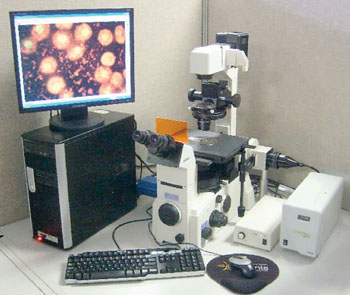Novel Device Yields Close-Up Look at Metastasis
By LabMedica International staff writers
Posted on 17 Nov 2014
A laboratory device has been invented that gives an unprecedented microscopic look at metastasis, the complex way that tumor cells spread through the body, causing more than 90% of cancer-related deaths.Posted on 17 Nov 2014
One difficulty in studying metastasis stems from the complexity of the interface between the tumor microenvironment and the vascular system, but the newly developed investigational platform positions tumor cells next to an artificial vessel embedded in an extracellular matrix (ECM).

Image: The Nikon Eclipse TE2000-U Inverted Fluorescence Microscope (Photo courtesy of Carmet Scientific).
Scientists at Johns Hopkins University (Baltimore, MD, USA) used live-cell fluorescence microscopy to analyze the complex interplay between metastatic cancer cells and a functional artificial microvessel that was lined with endothelial cells. The ECM/vessel platform is composed of a cylindrical collagen channel located within a polydimethylsiloxane (PDMS) housing that is perfused by a gravity flow system.
Time-lapse, phase-contrast, and fluorescence images were captured using automated image acquisition software with a TE-2000 U microscope (Nikon; Tokyo, Japan). A 10× objective was used for all epifluorescence and phase-contrast imaging. Permeability was measured through quantitative fluorescence detection of molecular transport from inside the vessel to the surrounding ECM. A nutrient-rich solution flows through the artificial vessel, mimicking the properties of blood. The breast cancer cells, inserted individually and in clusters in the tissue near the vessel, are labeled with fluorescent tags, enabling their behavior to be seen, tracked and recorded via a microscopic viewing system.
The investigators were able to record video of the movement of individual cancer cells as they crawled through a three-dimensional collagen matrix. This material resembles the human tissue that surrounds tumors when cancer cells break away and try to relocate elsewhere in the body. This process is called invasion. They were able video single cancer cells prying and pushing their way through the wall of an artificial vessel lined with human endothelial cells, the same kind that line human blood vessels. By entering the bloodstream through this process, called intravasion, cancer cells are able to hitch a ride to other parts of the body and begin to form deadly new tumors.
Peter C. Searson, a professor and senior author of the study said, “We were able to build a functional artificial blood vessel and a microenvironment that lets us capture the details of the metastatic process. In the past it's been virtually impossible to see the steps involved in this process with this level of clarity. We've taken a significant leap forward.” The study was published on September 1, 2014, in the journal Cancer Research.
Related Links:
Johns Hopkins University
Nikon








 (3) (1).png)





